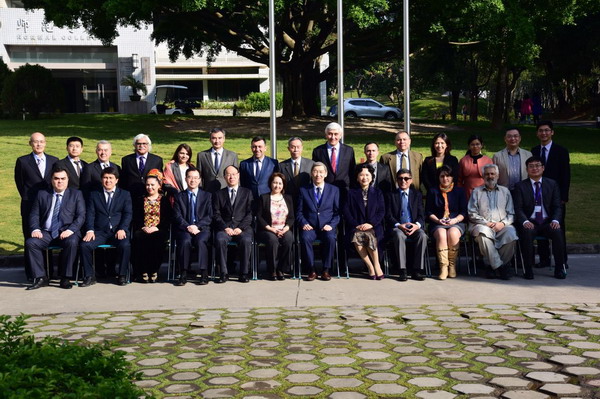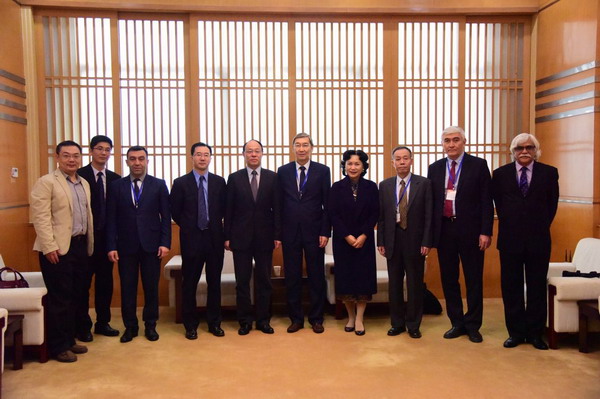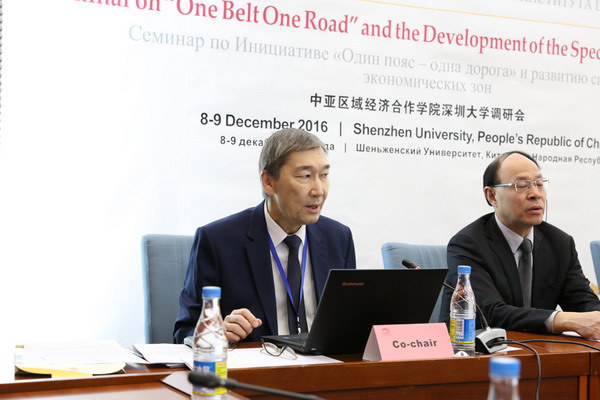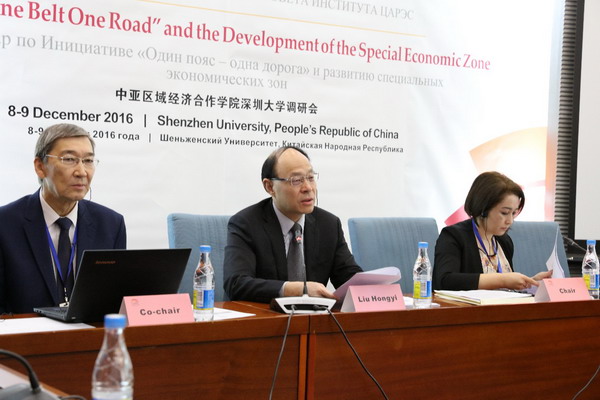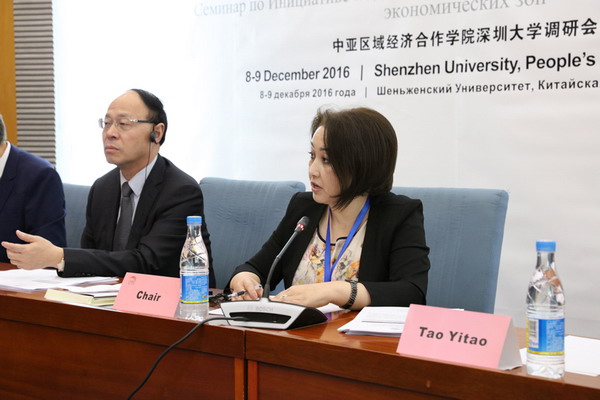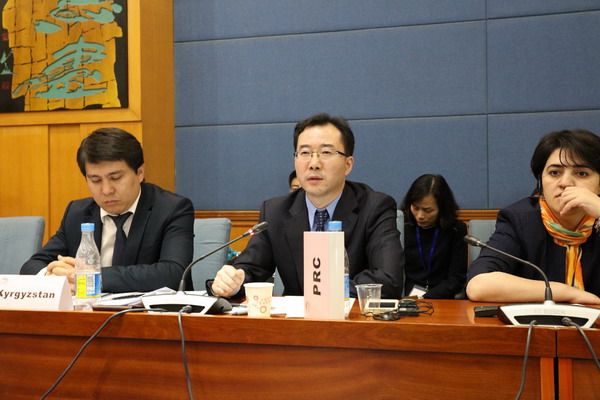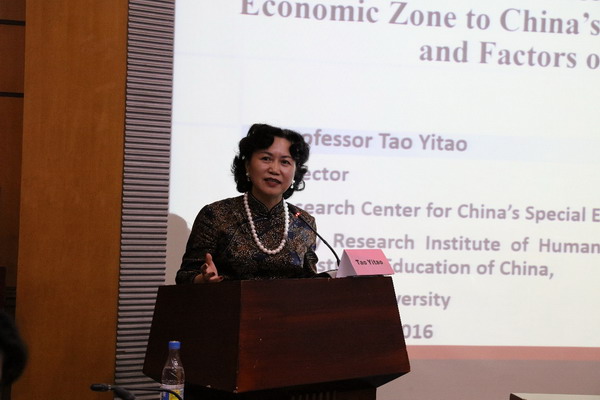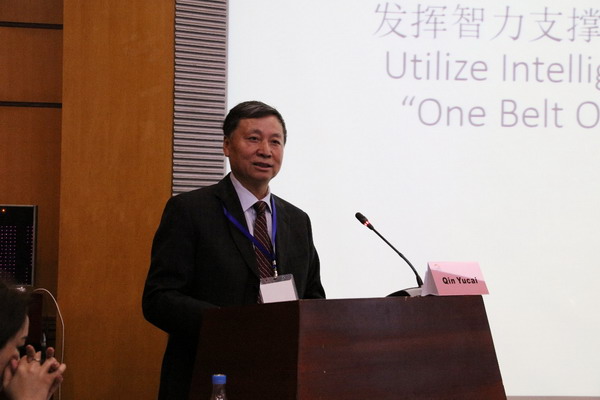On December 8, a research meeting was held at Shenzhen University (SZU) by council members of the Central Asia Regional Economic Cooperation Institute (CARECI) from the People's Republic of China, Afghanistan, Azerbaijan, Kazakhstan, Kyrgyzstan, Mongolia, Pakistan, Tajikistan, Turkmenistan, Uzbekistan and Asian Development Bank (ADB) in this favorable season when flowers blossom in the south while snowflakes fall in the north. The members discussed the internationalization of Chinese special economic zone mode and its correlation with the "Belt and Road" initiative, a platform for cooperative development. Attendees at the meeting included Prof. Liu Hongyi, secretary of CPC Committee of SZU, Prof. Tao Yitao, vice secretary of CPC Committee of SZU, secretary of the Discipline Inspection Commission of SZU and director of the China Center for Special Economic Zone Research (CCSEZR), Mr. Cheng Zhijun, deputy director general of the Department of International Economic and Financial Cooperation of the Ministry of Finance of the People's Republic of China, Ms. Kayumova, deputy minister of the Ministry of Economic Development and Trade of the Republic of Tajikistan, Mr. Umurzakov, director of CARECI, Mr. Liang Ziqian, deputy director of CARECI and relevant experts from SZU and CARECI.
Prof. Liu Hongyi, Ms. Kayumova and Mr. Umurzakov delivered speeches at the opening ceremony of the research meeting. Prof. Tao Yitao delivered a speech entitled "Historical Contribution of Shenzhen Special Economic Zone to China's Reform and Opening-up and Factors of Success" at the meeting.
Secretary Liu Hongyi said that China has continuously maintained significant economic and cultural links with Central Asia for thousands of years.
Today, as an important emerging economy in the world, China again becomes the engine to propel the Euro-Asia development. The Chinese government proposes and vigorously implements the "Belt and Road" initiative to strengthen communication and consultation between countries along the route including those in Central Asia and promote practical cooperation between China and these countries. China has formed its own economic development model with Chinese characteristics through years of innovations since the beginning of the reform and opening-up. In particular, the model of special economic zones exemplified by Shenzhen has drawn great attention and wide applause of academic and political circles at home and abroad. SZU is willing to enhance mutually beneficial cooperation with educational institutions in Central Asian countries and feels obliged to play its due role in the development of the "Belt and Road" strategy.
Deputy secretary Tao Yitao said in her speech that Shenzhen as the most typical and successful special economic zone in China has made four major historical contributions to China's reform and opening-up and there are seven factors of success. She also pointed out that Shenzhen, as a representative special economic zone in China, heralds the end of an age and the start of another. Shenzhen indicates and leads the direction of China's institutional changes and introduces a brand -new fruitful social development model. Through continuous innovations, Shenzhen has achieved miraculous social transformation and created new concepts, spirits and ideas apart from wealth. Therefore, the history of Shenzhen reflects not only the growth of a city but also the exploration of institutional changes and development roads of a country in transformation and the endeavor of a nation to seek prosperity and improvement. Special economic zones are the starting point of the reform and opening-up of China and the China's path as well as the test fields and pilot areas of China's reform and opening-up policy. Special economic zones are the right choice of a country that has implemented planned economy for nearly half a century and seeks stable and low-cost social transformation, a must-pass road for a poor country with a population of over a billion people that hopes to achieve common prosperity for all people, and a shortcut to modernization for a society with a serious imbalance between the development of rural and urban areas.
Mr. Umurzakov, on behalf of the management team of CARECI, extended his most sincere gratitude to secretary Liu Hongyi, deputy secretary Tao Yitao and attendees from SZU and various countries. He said that CARECI will continue to support the cooperation between member countries to explore the development potential of inland areas in Asia. After the research in SZU and the inspection in Shenzhen, CARECI will continue to provide training and education services for member countries with regard to their development and construction to introduce advanced and open-minded social concepts and development models in Central Asia and provide an important platform to help Central Asian countries go global.
Group photo of attendees at the SZU Research Meeting of CARECI
Prof. Liu Hongyi, Prof. Tao Yitao, Mr. Umurzakov and his party
Mr. Umurzakov presides over the opening ceremony
Prof. Liu Hongyi delivers a speech at the opening ceremony
Ms. Kayumova delivers a speech at the opening ceremony
Mr. Cheng Zhijun delivers a speech
Prof. Tao Yitao delivers a speech at the meeting
Mr. Qin Yvcai, expert from the "Belt and Road" institution of the International Cooperation Center of China's National Development and Reform Commission (NDRC) and former director general of the Department of Western Region Development of NDRC, delivers a speech at the meeting
